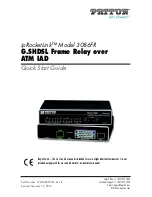
C-2
Netopia ISDN Router Reference Guide
About IP addressing
Ever y networking protocol uses some form of addressing in order to
ensure that packets are delivered correctly. In IP, individual network
devices that are initial sources and final destinations of packets are
usually called hosts, instead of nodes, but the two terms are inter-
changeable. Each host on an IP network must have a unique IP
address. An IP address, also called an Internet address, is a 32-bit
number usually expressed as four decimal numbers separated by
periods. Each decimal number in an IP address represents a 1-byte
(8-bit) binar y number. Thus, values for each of the four numbers
range from 00000000 to 11111111 in binar y notation, or from 0 to
255 in decimal notation. The expression 192.9.200.3 is a typical
example of an IP address.
IP addresses indicate both the identity of the network and the
identity of the individual host on the network. The number of bits
used for the network number and the number of bits used for the
host number can var y, as long as cer tain rules are followed. The
local network manager assigns IP host numbers to individual
machines.
IP addresses are maintained and assigned by the InterNIC, a
quasi-governmental organization now increasingly under the
auspices of private industr y.
Note:
It’s ver y common for an organization to obtain an IP address
from a third par ty, usually an Internet ser vice provider (ISP). ISPs
usually issue an IP address when they are contracted to provide
Internet access ser vices.
The InterNIC (the NIC stands for Network Information Center) divides
IP addresses into several classes. Classes A, B, and C are assigned
to organizations who request addresses. In Class A networks, the
first byte of an IP address is reser ved for the network por tion of the
address. Class B networks reser ve the first two bytes of an IP
address for the network address. Class C networks reser ve the first
three bytes of an IP address for the network address. In all cases, a
network manager can decide to use subnetting to assign even more
bits to the network por tion of the IP address, but never less than
the class requires. The following section gives more information on
subnetting.
Summary of Contents for 430 S/T
Page 1: ...Netopia ISDN Router Reference Guide F on arall Farallon Communications Inc...
Page 133: ...6 20 Netopia ISDN Router Reference Guide...
Page 173: ...8 8 Netopia ISDN Router Reference Guide...
Page 192: ...Monitoring Tools 9 19...
Page 193: ...9 20 Netopia ISDN Router Reference Guide...
Page 255: ...F 2 Netopia ISDN Router Reference Guide...
Page 276: ......















































